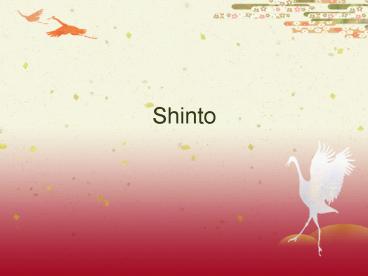Shinto PowerPoint PPT Presentation
1 / 23
Title: Shinto
1
Shinto
2
What religions to people claim to follow?
3
I. Religious Data
- 10 million Japanese participate in the rituals of
Shinto - One half of the population considers itself
Shinto - Followers feel a strong bond or connection with
nature
4
II. Background
- Shinto was formed around 550 BC in Japan
- Shinto is practiced exclusively in Japan or with
people of Japanese heritage - The religion has not spread dramatically to other
nations
5
III. Beliefs
- There is no all-powerful God in Shinto
- They worship Kami
- Kami are Gods and spirits that rule over nature
and human life - They are believed to run the world through
geographical sites (Mt. Fuji) and are natural
phenomenon
6
- Wa (benign harmony) is part of nature and human
relationships - Anything that disturbs wa is bad. To keep the
balance of harmony, there are rules to keep
society and the natural world from turning into
chaos - Wa is reflected in everyday actions. For
example, taking daily baths
7
- Renewal and Purification
- Man is kamis child. Life was given to people by
kami and is sacred - Purification is necessary to keep nature divine
- A shrine dedicated to Kami has a trough of pure
water used for cleansing the hands and mouth
8
- Shinto is not concerned with death and the
afterlife - Shinto is considered a life religion
- Many shintoists are also Buddhist to deal with
the question of the afterlife
9
IV. Culture
- Shinto religion is tied to the traditions,
customs, and values of the Japanese - Japanese society stresses the importance of
respect and character - The removal of shoes before entering a home is a
Shinto practice that is part of Japanese culture
10
- Flower arranging, Japanese architecture, and
garden design all have roots in Shinto practice - In sumo wrestling, salt is used to purify the
wrestling ring as part of Shinto practice
11
V. Ecology
- Shinto teaches people to be gentle to nature
- Everything given to humans from nature is sacred
- Pollution is an act of evil or sin
12
- Natural landscapes are sacred places
- Shrines are placed in sacred natural places
- Shrines are always guarded by animal statues
- A Torii gate is a symbol of Shintoism and is
placed at the entrance to a shrine - Shrines contain a symbol that represents a kami
- Shrines in homes are protected with white paper
to keep impure spirits away
13
Torii Gates mark the entrance to a Shinto shrine
14
Komainu (Guardian dogs) at the entrance to the
shrine
- At Inari shrines, the guardians are foxes
15
Purification trough at entrance
16
Fushimi Inari Shrine hiking trails covered with
Torii gates
17
Yakusumi Shrine commemorating Japans war dead
18
Zen Buddhism
- Brought from China in the 1200s
- Focus on meditation and enlightenment, all people
are capable of enlightenment
19
Zazen
- Zazen is meditation that includes body position,
hand position, and breathing - The focus is on letting go through non-thinking
20
- Zen appears in culture through gardening, ink
painting, calligraphy and even military service
21
What is a Koan?
- Aid to meditation
- Question or puzzle that cant solve with reason
- Out of frustration comes another kind of
awareness - Only used by some sects of Zen
22
(No Transcript)
23
(No Transcript)

